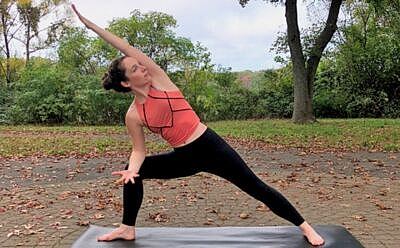Side angle pose

If you look this pose up on the internet, most entries list it as "utthita pārśvakoṇāsana" or extended side-angle pose. The illustration accompanying these articles indicates what the utthita means. The lower hand is extended to the floor. It is especially disappointing to find this description with phrases like "master the pose", or finding it described with hand to floor on a page "yoga for beginners". This extended version is not a beginners pose, and for many it will never be something that is going to happen. But that does not mean that you have no mastery of the pose. Indeed a truer mastery of postural yoga is to know, understand and respect one's own body and its limitations, and to find alignment and ease in the pose as you can do it.
This pose is a creation of modern postural yoga, it is not mentioned in any of the medieval hatha yoga texts. It seems to have been a creation of Tirumalai Krishnamacharya, whose students include the globally influential BKS Iyengar and Patabhis Jois.
The pose strengthens the all parts of the legs, encourages opening in the inner groin and side body and encourages increased range of motion in the shoulders.
The foot position is as for other standing poses such as triangle pose and the warrior poses, with a wide stance and the rear foot angled while the front foot points directly ahead. The front knee is bent and as always, the knee should track in alignment with the foot. The torso is rotated as for warrior 2 pose and then lent over the front leg. Most people will find that bringing the forearm to the front thigh is preferable to extending the hand to the floor. The upper side body is lifted towards the ceiling and the upper side arm can be extended and raised to lie next the the ear, forming a straight line from the rear foot to the hand.
Things to think about and observe in this pose:
- Can you keep both left and right sides of the body long and even?
- Can you keep the front and the back of the body even, so the spine is not in extension (back bending) nor in flexion (forward bending)?
- Can your head be in alignment with the spine?
- Can you even the weight under the feet?
- Is there a clear line of force from the top hand into the back foot?
Ways you could play with this pose as you use it to explore yourself:
- Place the hands on the sides of the ribs as you come into it, and feel if one side is shortening and exploring what it will feel like, and how far you could go without that happening.
- Place the hands on the front and the back of the body as you come into it to check for flexion and extension, and see what you would need to change to have no change under your hands, evenness on both sides.
- Explore giving priority to keeping the upside ribs directed towards the sky rather than to how far down you can reach.
Hope you have fun finding fresh revelations through pārśvakoṇāsana.
Photo credit: yogiapproved.com - one of the only images discovered of this pose that is in good alignment and displaying the accessible version with the arm to the thigh.
(Author, Tina Shettigara)